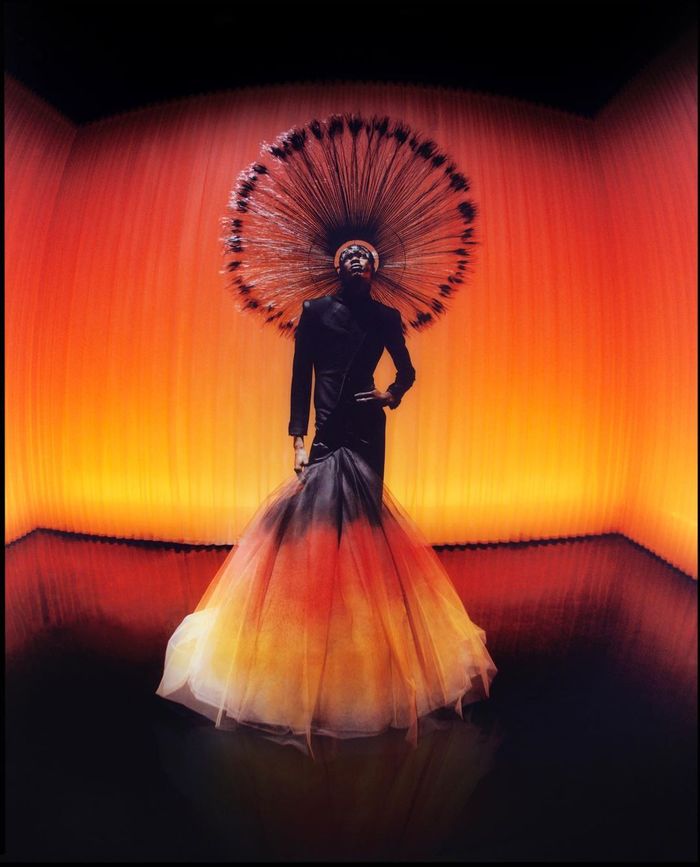Designer Spotlight: Molly Goddard
Olivia Rhodes explores how Molly Goddard’s presentation of prettiness through elaborately frilled designs subverts traditional femininity and promotes confidence above all
Only a true talent can successfully dress fictional psychopathic assassins, pop stars, and supermodels — a talent not just in fashion, but in representation of womanhood. Molly Goddard pioneers a new kind of female dressing; the froth and frills that have become her signature make her pieces instantly recognisable. At first glance, Goddard’s tulle creations might be described as ‘pretty’, but this is an association she problematises: ‘it often has connotations of weakness; it doesn’t feel like a very strong word’. She instead aims for her pieces to communicate a confidence, a boldness that can empower the wearer of her pieces.
“Breaking away from gender expectations does not mean self-presentation must turn towards masculine display”
The most memorable embodiment of such collected confidence is no doubt Killing Eve’s iconic assassin Villanelle, who wore a bubblegum-pink Molly Goddard dress paired with chunky black Balenciaga boots in the first season. Such a subversive ensemble espoused complete self-assurance, revealing that dressing a killer in killer clothing is the ultimate power statement. Putting a defiantly daring character in tulle fabric and the kind of ruffled embellishments traditionally used in classical contexts was an infamous force of confidence. Whilst each of Villanelle’s outfits were perfectly constructed and infinitely stylish, Goddard’s dress springs to mind instantly: a testament to the volumes, literally and conceptually, that her designs speak.
The wearer does not have to be an irrepressible psychopath for Molly Goddard to create pieces which communicate the same bold message of unabashed womanhood. The recurrence of frills and frothy dresses in her collections is a tongue-in-cheek reminder that breaking away from gender expectations does not mean self-presentation must turn towards masculine display. The dress in itself is a piece historically ascribed exclusively to women, but the loose fit of Goddard’s dresses means the attention is solely on the clothes and face rather than on the female bodily form. The feminine potential of Molly Goddard’s tropes means she can lean into that if needed, as exemplified by Francesca Hayward’s June 2021 Harper’s Bazaar cover, where white tulle contributed to the ballet dancer’s image. Elsewhere, bright, block colours mean that there is no danger of a Goddard piece fading into the background — her faith in clashing colours demonstrates an anarchism that makes people look twice. Frequent styling with bold boots or punky make-up ensures that femininity meets fearlessness.
It is for this reason that celebrities are increasingly gravitating towards Goddard as a red-carpet choice. At 2021’s Golden Globes, both Rosamund Pike and Nicola Coughlan wore the brand, exhibiting different aesthetics, but propelling both onto many a best-dressed list of the evening. Pike wore a vibrant scarlet with black accents, paired with stompy boots, a red lip, and a poker-straight bob, while Coughlan sported a primrose yellow, with a cardigan tied in a bow and pastel green bobby pins in tousled hair. Long-time fan Rihanna wore a neon lilac with laced up silver heels at the Fenty Beauty launch, but a pastel pink tunic dress over a sweatshirt and jeans at a women’s march in New York. The varying circumstances in which Molly Goddard is a successful choice demonstrate how her pieces are wearable far beyond the reach of a runway. They are easily adaptable to the wearer and their intentions, suggestive of the widespread aspiration for the confidence that dresses such as these instil.
Ultimately, that is what fashion should do. While it has the scope to be political and controversial, or conversely trivialised, clothes have the power to entirely modify an individual’s perception, both of themselves and from others. This is something that Molly Goddard as a designer is evidently aware of, advocating confidence as the most fundamental accessory. Aware that her brand has been seen by some as frilly princess dresses for people to feel pretty in, she has worked tirelessly to reformulate this diminutive evaluation. This work has paid off, and while a lot of her pieces are undeniably ‘pretty’, it is a prettiness that is distinctly powerful.
 News / Caius mourns its tree-mendous loss23 December 2025
News / Caius mourns its tree-mendous loss23 December 2025 Comment / Yes, I’m brown – but I have more important things to say22 December 2025
Comment / Yes, I’m brown – but I have more important things to say22 December 2025 News / Clare Hall spent over £500k opposing busway 24 December 2025
News / Clare Hall spent over £500k opposing busway 24 December 2025 Interviews / Politics, your own way: Tilly Middlehurst on speaking out21 December 2025
Interviews / Politics, your own way: Tilly Middlehurst on speaking out21 December 2025 News / King appoints Peterhouse chaplain to Westminster Abbey22 December 2025
News / King appoints Peterhouse chaplain to Westminster Abbey22 December 2025









